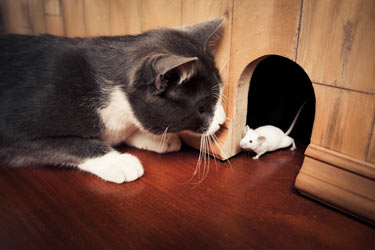Bubonic Plague: Cats are Highly Susceptible

Bubonic plague. The Black Death. Pestilence. These are all terms that strike fear into the hearts of humans everywhere. This infection has taken the lives of millions of people over the centuries. It might surprise you to know that, not only does plague still take lives today, but it is present in the United States, mostly in Arizona, Colorado, and New Mexico.
Current (April, 2015) Events: Plague Found Near Flagstaff, Arizona
Officials recently noticed a lack of prairie dog activity in burrows in Picture Canyon, just outside of Flagstaff, Arizona. Fleas collected from the burrows tested positive at a lab for Yersinia pestis, the bacteria that causes plague. This bacteria is transmitted through the bite of infected fleas or rodents, through direct handling of infected animals, or through breathing it in when it becomes aerosolized under certain disease conditions (see "pneumonic plague" below).
The area in Arizona was sprayed with insecticides in an attempt to kill the fleas and stop the spread of plague. Hikers near the infected burrows are being cautioned to wear long pants, socks, and covered shoes while hiking. While dogs are highly resistant to developing plague, they can carry infected fleas home. These fleas may then bite humans or household cats, and those two species are highly susceptible to developing the illness.
Cats and Plague
Cats are extremely vulnerable to developing illness when they are exposed to Yersinia pestis. They are also a very common source of infection to humans. There are three symptom sets that plague can develop into:
- Bubonic plague: This is the most common variation of plague in humans and cats. The bacteria heads to the lymph node that is closest to their point of entry into the body. The lymph node then swells, becomes painful, and often bursts, becoming a draining sore. These painful lymph nodes are called buboes.
- Septicemic plague: This type of plague occurs when the bacteria multiply in the blood stream rather than the lymphatic system.
- Pneumonic plague: This is the least common but most deadly form of plague. It can occur in late stages of the other forms of plague, when the bacteria moves to the lungs, or it can develop when a person contracts plague by breathing it in from droplets that have been coughed into the air by a victim already suffering from pneumonic plague. This is a dangerous form of plague because it is very easily spread and it is more resistant to treatment than other forms.
How Do Cats Get Plague?
Cats can be exposed to plague bacteria in any of the following ways:
- Bites or scratches from infected rodents
- Bites from infected rodent fleas
- Eating a rodent that was infected with plague
- Outdoor cats more commonly acquire plague than their indoor counterparts
How Can Cats Transmit Plague to People?
Cats can transmit plague to humans by biting or scratching them. People can be exposed to the illness through direct contact with a plague cat's draining lymph node material (buboes). An infected cat may also carry fleas that can transmit Yersinia pestis to humans by biting them. If a cat has the pneumonic form of plague, it can easily be spread to humans through the air. Owners and veterinarians are at risk of contracting plague when dealing with an infected cat.
Signs of Plague in Cats
- Fever
- Lethargy
- Inappetance and weight loss
- Firm, painful swellings under the jaw or behind the front legs: these may burst open and drain
- Vomiting and diarrhea
- Dehydration (learn about the signs of dehydration in cats here)
If you notice any of the signs of illness listed above in your cat, see your veterinarian immediately. If you are in or have visited an area that is known to have plague, mention it to the doctor.
Treatment of Plague in Cats
Plague is treated with a variety of antibiotics. Most cases respond well if they are caught and treated early in the disease process. Cats with the pneumonic form of plague need to be isolated and treated by people wearing full protective gear such as gloves and masks.
General Plague Prevention Tips
- If you or your cat is sick, see a doctor or go to the veterinarian immediately.
- If you live in or visit areas where plague is known to occur, use regular flea control on both your dogs and your cats, even if your cat stays indoors. Ask your veterinarian for a recommendation on the best flea preventatives for your pets.
- Get rid of areas around your home that could attract rodents, such as brush piles, logs, and rock clusters.
- Make your home as rodent-proof as possible.
- Do not handle dead animals unless it is absolutely necessary. In that case, wear disposable gloves and a mask.
- When hiking in areas known to have had plague, wear long pants, socks, and closed shoes. Check your ankles for fleas before getting back into your car.
You May Also Like These Articles:
How to Be Prepared for Your Cat's Veterinary Bills
How To Take Your Cat To The Vet
Pet Insurance: Peace of Mind for Your Cat's Health
Subcutaneous Fluid Therapy: Giving Your Cat Fluids at Home
Upper Respiratory Tract Conditions in Cats





